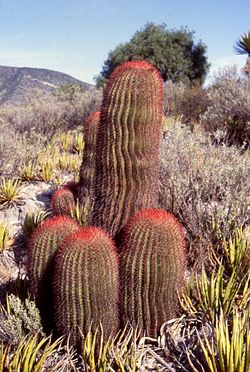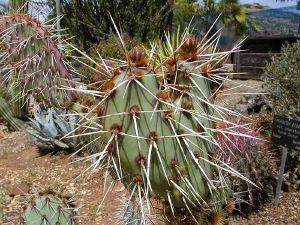Cactus
| Cacti | ||||||||||
|---|---|---|---|---|---|---|---|---|---|---|
 Ferocactus pilosus (Mexican Lime Cactus) growing south of Saltillo, Coahuila, northeast Mexico
| ||||||||||
| Scientific classification | ||||||||||
| ||||||||||
|
See Taxonomy of the Cactaceae |
Cactus is the name given to any member of the flowering plant family Cactaceae. Cacti are almost exclusively New World plants. This means that they are native only in North America, South America, and the West Indies. There is however one exception, Rhipsalis baccifera; this species has a pantropical distribution, occurring in the Old World in tropical Africa, Madagascar and Sri Lanka as well as in tropical America. This plant is thought to be a relatively recent colonist in the Old World (within the last few thousand years), probably carried as seeds in the digestive tracts of migratory birds. Many other cacti have become naturalized to similar environments in other parts of the world after being introduced by people.
Many succulent plants in both the Old and New World bear a striking resemblance to cacti, and are often called "cactus" in common usage. This is, however, due to parallel evolution; none of these are closely related to the Cactaceae. One distinct identifying characteristic of the Cactus family is the areole, a specialized structure from which spines and new shoots grow.
Cacti are believed to have evolved in the last 30 to 40 million years. Long ago, the Americas were joined to the other continents, but separated due to continental drift. Unique species in the New World must have developed after the continents had moved apart. Significant distance between the continents was only achieved around in the last 50 million years. This may explain why cacti are so rare in Africa; the continents had already separated when cacti evolved.
Like other succulents, cacti are well-adapted to life with little precipitation. The leaves have evolved into spines, which in addition to allowing less water to evaporate through transpiration than regular leaves, defend the cactus against water-seeking animals. Photosynthesis is carried out by enlarged stems, which also store water. Unlike many other succulents, the stem is the only part of a true cactus where this takes place. Very few members of the family have leaves, and when present these are usually rudimentary and soon fall off; they are typically awl-shaped and only 1-3 mm long. Two genera, Pereskia and Pereskiopsis, do however retain large, non-succulent leaves 5-25 cm long, and also non-succulent stems. Pereskia has now been determined to be the ancestral genus from which all other cacti evolved [1].
Cacti come in a wide range of shapes and sizes. Some grow to great size. Some cacti produce beautiful flowers, which like spines and branches arise from areoles. Many cactus species are night-blooming, as they are pollinated by nocturnal insects or small animals, principally moths and bats. Cacti range from small and round to pole-like and tall, such as the Saguaro.
A number of cactus species are cultivated for use as houseplants, as well as for ornamental gardens. They often form part of xerophilic (dry) gardens in arid regions. Some cacti bear edible fruit.
Selected important genera include the following; for a full list see Taxonomy of the Cactaceae
- Acanthocereus - triangle cactus
- Ariocarpus - living rock
- Bergerocactus - snakecactus
- Carnegiea - saguaro
- Cephalocereus - old man cactus
- Cereus - sweetpotato cactus
- Coryphantha - beehive cactus
- Echinocactus - barrel cactus
- Echinocereus - hedgehog cactus
- Echinopsis - sea-urchin cactus, Easter lily cactus
- Epiphyllum - climbing cactus
- Epithelantha - pingpong ball cactus
- Escobaria - foxtail cactus, pincushion cactus
- Ferocactus - barrel cactus
- Gymnocalycium - Chin cactus
- Harrisia - applecactus
- Hylocereus - nightblooming cactus
- Lophophora - peyote
- Mammillaria - fishhook cactus, globe cactus, bird's-nest cactus
- Opuntia - prickly pear, cholla
- Pediocactus - hedgehog cactus
- Pilosocereus - tree cactus
- Schlumbergera - holiday cactus
- Sclerocactus - fishhook cactus
- Selenicereus - moonlight cactus, nightblooming cereus
- Turbinicarpus - top cactus
Etymology
The word cactus is ultimately derived from Greek Κακτος kaktos, used in classical Greek for a species of spiny thistle, possibly the cardoon, and used as a generic name, Cactus, by Linnaeus in 1753 (now rejected in favor of Mammillaria). There is some dispute as to the proper plural form of the word; as a Greek loan into English, the correct plural in English would be "cactuses". However, as a word in Botanical Latin (as distinct from Classical Latin) "cactus" would follow standard Latin rules for pluralization and become "cacti", which has become the prevalent usage in English.
References and external links
- Anderson, Edward F. The Cactus Family (Timber Press, 2001) ISBN 0-88192-498-9 - Comprehensive and lavishly illustrated
- Benson, Lyman The Cacti of Arizona (The University of Arizona Press, 1981) ISBN 0-8165-0509-8 - Thorough treatment of the Arizona, U.S.A., species
- CactiGuide - many photos, and discussion forum
- Cactus portal
- Cactus Gallery
Credits
New World Encyclopedia writers and editors rewrote and completed the Wikipedia article in accordance with New World Encyclopedia standards. This article abides by terms of the Creative Commons CC-by-sa 3.0 License (CC-by-sa), which may be used and disseminated with proper attribution. Credit is due under the terms of this license that can reference both the New World Encyclopedia contributors and the selfless volunteer contributors of the Wikimedia Foundation. To cite this article click here for a list of acceptable citing formats.The history of earlier contributions by wikipedians is accessible to researchers here:
The history of this article since it was imported to New World Encyclopedia:
Note: Some restrictions may apply to use of individual images which are separately licensed.


